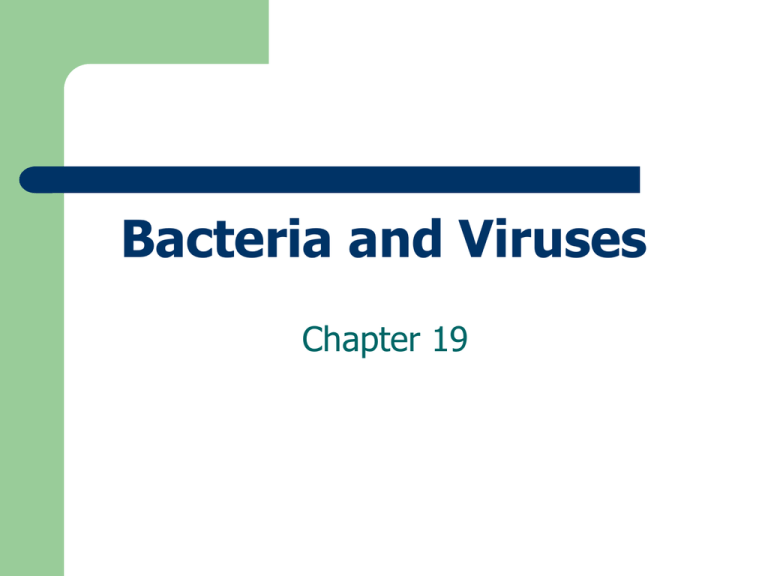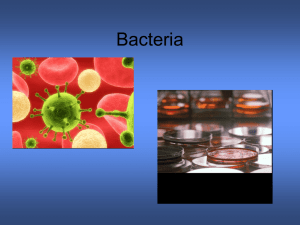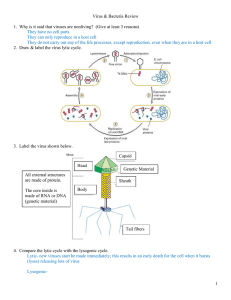Bacteria and Viruses Chapter 19
advertisement

Bacteria and Viruses Chapter 19 Bacteria & Viruses 19.1 Bacteria Come in many shapes and sizes Most common microorganisms are prokaryotes Average size of 1-5 micrometers – Compared to eukaryotic cells that are 10-100 micrometers in diameter 2 Branches of Bacteria (Domains) Archebacteria (similar to early Earth) – Confined to extreme environments Methanogens - reduce CO2 to CH4 Extreme halophiles - salt loving – Thermoacidophiles – Similar to early earth More closely related to eukaryotes than to modern bacteria – – – Eubacteria (most modern) – very diverse Bacterial Classification Prokaryotic Phylogeny Prokaryotic & Eukaryotic Cells Classifying Prokaryotes Eubacteria – – – – – Largest prokaryote Domain Lack nuclei Cell wall of a carbohydrate- Peptidoglycan Cell membrane around cytoplasm Some have an extra cell wall on the outside to resist damage Classifying Prokaryotes Archaebacteria – – – – Lack nuclei Have cell walls without peptidoglycan Are chemically different from Eubacteria Many live in extremely harsh environments Bacteria Shapes Identifying Prokaryotes Shapes – – – Bacilli- Rod shaped Cocci- Spherical shaped Sprilla- spiral shaped Colorized SEM 9,000 Colorized SEM 12,000 Identifying Prokaryotes Cell walls – Gram staining used to tell them apart – Gram+ bacteria look purple – Gram- bacteria look pink The Bacterial Cell Wall Instead of cellulose, contain peptidoglycan – A polymer of modified sugars cross-linked with amino acids The gram stain distinguishes many disease causing bacteria based on the type of cell wall Many antibiotics work by attacking the bacterial cell wall The Gram Stain Gram (+) Purple – – accept gram stain have simpler cell walls with large amounts of peptidoglycan Gram (-) Pink – – – – – do not stain have more complex cell walls with less peptidoglycan cell walls contain lipopolysaccharides are more likely to be pathogenic (cause disease) more resistant to antibiotics Cell Wall & Gram Stain Gram (+) & Gram (-) Gram (+)Purple & Gram (-)Pink Identifying Prokaryotes Movement – Flagella – Lash, snake or spiral forward – They do not move at all Motility (movement) About half are capable of directional movement. 3 mechanisms: – – – flagella - different from eukaryotes spiral shaped bacteria (spirochetes) have a filament that spirals around the cell under the outer sheath some bacteria secrete slimy chemicals & glide Taxis – – movement toward or away from a stimulus many bacteria exhibit this form of movement Structures of Movement Structure of Prokaryotic Flagella Metabolic Diversity Heterotrophs – Chemoheterotrophs: must take in organic molecules for energy and carbon – Photoheterotrophs: Use sunlight for energy but need organic compounds for a carbon source Metabolic Diversity Autotrophs – Chemoautotrophs: perform chemosynthesis to make carbon from carbon dioxide. Does not require sunlight – Photoautotrophs: use light to convert carbon dioxide and water into carbon compounds and oxygen gas. Getting Energy Bacteria need a constant supply of energy Obligate aerobes- require constant supply of oxygen Obligate anaerobes- need no oxygen, for some oxygen will kill it Facultative anaerobes- survive with or with out oxygen Growth and Reproduction Binary fission (to split) Conjugation Spore formation Binary Fission Bacterial Conjugation Endospores (example: Anthrax) Some bacteria form resistant cells called Resist extremes of temperature, pH, etc. endospores (11,000 year old spores found) Importance of Bacteria Only a minority cause disease Many are essential to life on earth Decomposers – Nitrogen Fixers – Break down dead matter Converts nitrogen into a form plants can use Humans use Bacteria Often live in symbiotic relationships with other organisms 19.2 Viruses What is a virus? – Particles of nucleic acid and proteins – Core made up of DNA or RNA surrounded by a capsid Head – Need to infect a living host to reproduce Tail Tail fiber DNA Viral Structure Bacteriophage Are Viruses Alive? Viruses contain nucleic acids & proteins Viruses, by themselves, cannot make or use food, grow or reproduce Some scientists believe viruses were never independently living organisms Others believe viruses evolved from simple bacteria like mycoplasmas & rickettsiae Another hypothesis: viruses are genes that have escaped from the genomes of living cells Not much evidence to support any one of these Viral Infection Lytic Cycle – – – – – – Virus attaches to host cell Injects its DNA Host makes RNA from viral DNA Cell begins to make copies of virus New viruses form Host cell bursts Lytic Cycle of the T4 Phage Viral Infection Lysogenic Cycle – – – – – Virus attaches to host cell Injects DNA Viral DNA incorporates itself into the host DNA Viral DNA can be dormant Once it becomes active, it follows the 4 processes in the lytic cycle Lytic and Lysogenic Cycle (video) http://www.youtube.com/watch?v=gU8XeqI7yts &feature=related Phage Lytic and Lysogenic Cycles Viral Infection Retrovirus: Genetic information is RNA – Produces DNA copy and creates a prophage Envelope – Example: HIV/AIDS Glycoprotein Protein coat RNA (two identical strands) Reverse transcriptase 19.3 Diseases Caused by Bacteria and Viruses Pathogens- disease causing agents Bacterial Disease Viral Diseases Diseases Caused By Bacteria How does bacteria produce disease? – Damage the cells and tissues by breaking down the cells for food – Releasing toxins (poisons into the body) Preventing Diseases Vaccines Immunity Antibiotics Controlling Bacteria Sterilization Disinfectants Proper food storage Diseases Caused by Viruses Viruses disrupt the body’s normal equilibrium Cannot be treated with antibiotics Viruses can infect humans and plants Virus-like Particles (Viroids) Viroids- single stranded RNA molecule with no capsid – They cause diseases in plants – Infect cell and produce more viroids by disrupting the plant metabolism Virus-like Particles (Prions) Prions- contain only protein; no DNA or RNA – They cause diseases in animals and humans – Prions clump and cause normal protein to clump with it- creating new prions Prion Action Chapter 19 Viruses and Bacteria Multiple Choice Practice Questions 19–1 –Which characteristic distinguishes eubacteria from archaebacteria? Eubacteria lack peptidoglycan in their cell walls. Eubacteria contain peptidoglycan in their cell walls. Eubacteria lack a nucleus. Eubacteria do not possess mitochondria. 19–1 –Which characteristic distinguishes eubacteria from archaebacteria? Eubacteria lack peptidoglycan in their cell walls. Eubacteria contain peptidoglycan in their cell walls. Eubacteria lack a nucleus. Eubacteria do not possess mitochondria. 19–1 – Rod-shaped prokaryotes are called bacilli. cocci. spirilla. streptococci. 19–1 – Rod-shaped prokaryotes are called bacilli. cocci. spirilla. streptococci. 19–1 – Bacteria that must live without oxygen are called obligate aerobes. facultative anaerobes. obligate anaerobes. facultative aerobes. 19–1 – Bacteria that must live without oxygen are called obligate aerobes. facultative anaerobes. obligate anaerobes. facultative aerobes. 19–1 – Prokaryotes that make their own food molecules from carbon dioxide and water but live where there is no light are called photoautotrophs. photoheterotrophs. chemoautotrophs. chemoheterotrophs. 19–1 – Prokaryotes that make their own food molecules from carbon dioxide and water but live where there is no light are called photoautotrophs. photoheterotrophs. chemoautotrophs. chemoheterotrophs. 19–1 – Bacteria that attack and digest the tissue of dead organisms are called decomposers. nitrogen fixers. chemoautotrophs. archaebacteria. 19–1 – Bacteria that attack and digest the tissue of dead organisms are called decomposers. nitrogen fixers. chemoautotrophs. archaebacteria. 19–2 – Viruses that contain RNA as their genetic information are known as prions. oncoviruses. retroviruses. bacteriophage. 19–2 – Viruses that contain RNA as their genetic information are known as prions. oncoviruses. retroviruses. bacteriophage. 19–2 – The first type of virus to be studied was the bacteriophage. tobacco mosaic virus. influenza virus. AIDS virus. 19–2 – The first type of virus to be studied was the bacteriophage. tobacco mosaic virus. influenza virus. AIDS virus. 19–2 –Which of the following statements about viruses is true? Viruses appear similar to bacteria when studied with a light microscope. Viruses display the essential characteristics of living things. Viruses can reproduce independently if they contain DNA. Viruses cannot reproduce unless they infect a living cell. 19–2 –Which of the following statements about viruses is true? Viruses appear similar to bacteria when studied with a light microscope. Viruses display the essential characteristics of living things. Viruses can reproduce independently if they contain DNA. Viruses cannot reproduce unless they infect a living cell. 19–2 – A virus integrates its DNA into the DNA of the host cell but remains inactive for a while in a lytic infection. a lysogenic infection. neither a lytic nor a lysogenic infection. retroviral infection. 19–2 – A virus integrates its DNA into the DNA of the host cell but remains inactive for a while in a lytic infection. a lysogenic infection. neither a lytic nor a lysogenic infection. retroviral infection. 19–2 – Retroviruses are considered unique because they have RNA in their capsid and not DNA. they have DNA in their capsid and not RNA. after infection of a host cell, their RNA makes DNA. after infection of a host cell, their DNA makes RNA. 19–2 – Retroviruses are considered unique because they have RNA in their capsid and not DNA. they have DNA in their capsid and not RNA. after infection of a host cell, their RNA makes DNA. after infection of a host cell, their DNA makes RNA. 19–3 –Biologists know that bacteria can cause human disease by entering cells and using the cell to make new bacteria. producing toxic substances that interfere with normal cell functi decomposing the remains of dead organisms. changing atmospheric nitrogen into nitrogen compounds. 19–3 –Biologists know that bacteria can cause human disease by entering cells and using the cell to make new bacteria. producing toxic substances that interfere with normal cell functio decomposing the remains of dead organisms. changing atmospheric nitrogen into nitrogen compounds. 19–3 – A process that destroys bacteria by subjecting them to great heat is known as refrigeration. sterilization. pickling. boiling. 19–3 – A process that destroys bacteria by subjecting them to great heat is known as refrigeration. sterilization. pickling. boiling. 19–3 – Which of the following diseases is transmitted by a mosquito bite? influenza measles West Nile virus chickenpox 19–3 – Which of the following diseases is transmitted by a mosquito bite? influenza measles West Nile virus chickenpox 19–3 – Which of the following diseases is thought to be caused by prions? diphtheria mad cow disease tuberculosis smallpox 19–3 – Which of the following diseases is thought to be caused by prions? diphtheria mad cow disease tuberculosis smallpox 19–3 – The best way to combat viral diseases is to use antibiotics. to treat individual symptoms. to use preventive vaccines. to let the disease “cure itself.” 19–3 – The best way to combat viral diseases is to use antibiotics. to treat individual symptoms. to use preventive vaccines. to let the disease “cure itself.”







